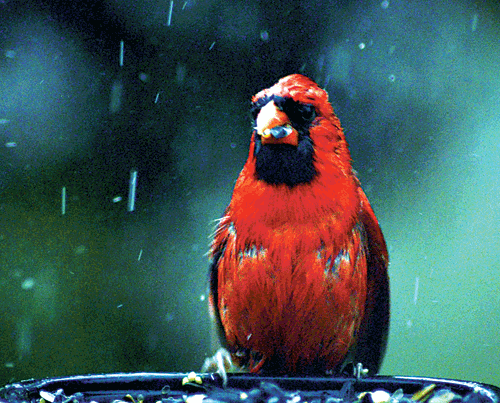BIRD OF THE SOUTH
 The cardinal is not a southern bird. But I think of it as one, as a bird with a similar distribution as the mockingbird. It was south to me when I was a boy. I lived in northern Iowa and cardinals were described as birds of the southern part of the state.
The cardinal is not a southern bird. But I think of it as one, as a bird with a similar distribution as the mockingbird. It was south to me when I was a boy. I lived in northern Iowa and cardinals were described as birds of the southern part of the state.
Then one summer a cardinal was heard and seen in my hometown. To birders, and to many people who were not birders, it was a sensation, a bright red bird which was said to be a visitor from farther south. It was reported on the front page of the town newspaper. Then and ever since it has been a bird of the south to me.
The actual range of the cardinal when I was a boy was from the Atlantic Coast west into Iowa and from the Gulf Coast north into southeastern Iowa, southern Wisconsin and Michigan, New York and even into southern Maine. It’s the state bird of Illinois, Indiana, Ohio, Kentucky, West Virginia, Virginia and North Carolina.
Now the range of the cardinal is even greater. It nests north into southern Canada, west across Iowa, southeastern South Dakota, much of Nebraska, all of Kansas and Oklahoma and most of Texas. It is now a common nesting bird in my hometown. Being non-migratory, that’s its permanent range, summer and winter.
Everybody who recognizes a robin must also recognize a cardinal. Slightly smaller than a robin, a male is bright red with a crest and a black face. Even its bill is red. A female is red on the back but not as bright as a male and is more orange than red on the breast and belly and has only a bit of black around the bill.
If I had any question about the appearance of a cardinal all I had to do was look at the bird feeder outside my window. There have been three cardinals, two males and a female, flying back and forth to the feeder with black-capped chickadees, house sparrows, white-breasted nuthatches, house finches and tree sparrows as I’ve been typing.
In spite of knowing the cardinal’s past and present distribution, before going to Georgia for Thanksgiving with my sister and brother-in-law and their family I told people I was going south into the land of those southern birds, the cardinal and the mockingbird.
My sister also stocks a bird feeder conveniently located for observation outside a window and when I first looked out I saw cardinals and chickadees. It was as if I was looking at the feeder outside my window at home. But then I thought, these chickadees are different. I knew these were truly birds of the south. These were Carolina chickadees. The difference in color between black-capped and Carolina chickadees is slight, however, a bit of shading here and there. The surest way to tell one from the other is by its whistled call. A black-capped chickadee has a two-note whistle call, a Carolina chickadee has a four-note whistle call.
I spent most of my visit talking, eating, watching TV. But I did go to a wildlife area one afternoon. There I saw great egrets, which I also see in northern Indiana but which are not as numerous and don’t nest as far north as I live. I saw a few wintering ducks, mallards and gadwalls, which I might also see in northern Indiana in winter where lakes and rivers are not frozen over. As we were driving to the swamp I saw turkey and black vultures. While the turkey vultures nest in northern Indiana, the black vultures are truly southern birds, at least south of northern Indiana.
I saw cardinals and mockingbirds on my trip to Georgia, but I saw only one true bird of the south, Carolina chickadee.
- Birds As Weather Forecasters – Life In The Outdoors - December 17, 2021
- Rare Bird Spotted In Indiana – Life In The Outdoors - October 8, 2021
- MY EXPERIENCE WITH DEER – Life In The Outdoors - July 30, 2021


